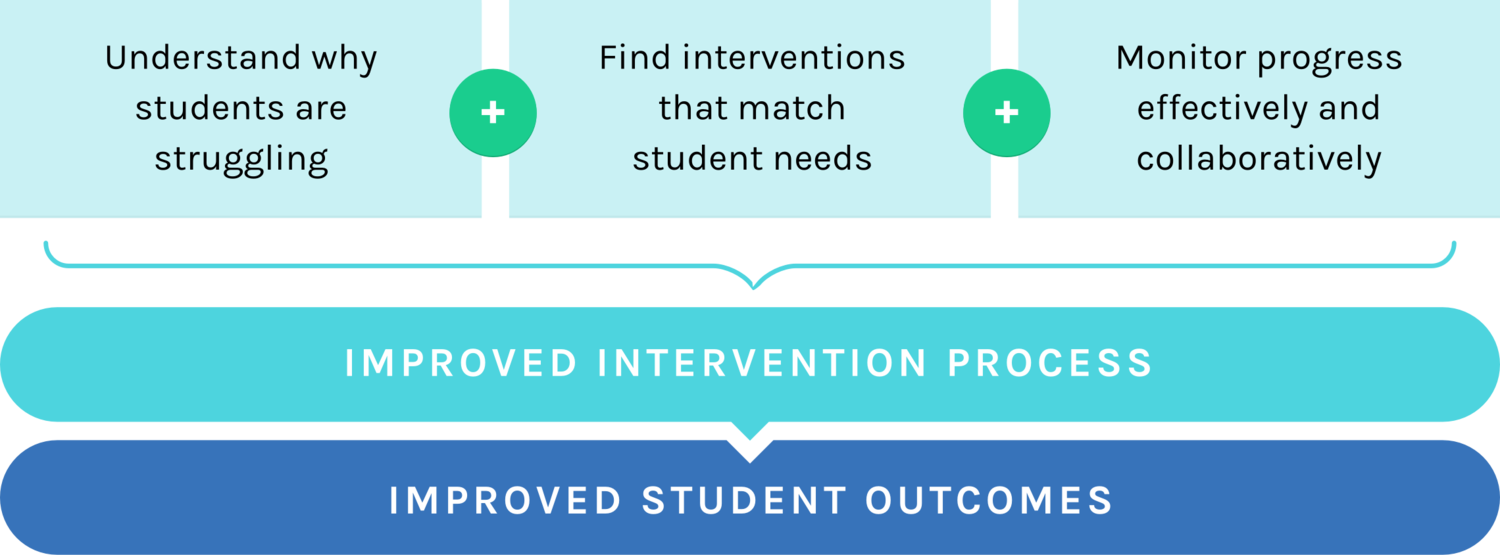
Theory of Change
The science behind Branching Minds
A systematic approach to delivering and monitoring interventions to struggling students has been shown to be very effective for remediating learning and behavioral challenges.1 However, such a system places demands on teachers that very few have been trained to meet.2 The Branching Minds theory of change highlights how if teachers are able to understand why students are struggling, find appropriate interventions, and monitor intervention efficacy, schools would be able to better implement an intervention system (proximal outcome) and student outcomes would improve (distal outcome).

Understanding why students struggle to master academic, behavioral, and social-emotional skills is critical for remediating learning challenges efficiently. Decades of established research have uncovered many of the specific cognitive, academic, and social-emotional skills necessary for educational success in certain domains. For example, through comprehensive factor analysis researchers and educators know that working memory, processing speed, and specific language skills—including phonemic awareness, phoneme-grapheme mapping, morphological awareness, syntax, and vocabulary are critical for reading decoding and fluency.3 4 5
Branching Minds provides an observation-based survey that helps teachers understand why a student is struggling in a particular academic domain by narrowing in on the cognitive and academic skills within a specific academic area. The questions in the Branching Minds survey are based on research that reveals what it looks like when students are struggling with specific cognitive skills.6 The wording of the questions and scaffolding for observing the behaviors are developed and reviewed by a team of cognitive psychologists, veteran educators, and expert consultants, ensuring the platform is teacher-friendly and consistent with the scientific research and psychometric standards.
The Branching Minds platform also integrates and displays results from various evidence-based and nationally normed assessment providers. All of these scores can be viewed on students’ overview pages by teachers who work with them. Results from nationally normed assessments can also be pulled into various reporting features on the platform to show growth over time for different cohorts of students. This reporting helps educators get a deeper understanding of students’ academic, social-emotional, and behavioral needs, develop targeted intervention plans, and evaluate the outcomes of those plans.
Another critical part of addressing the needs of students is through finding interventions that are effective for remediating learning challenges. These programs, strategies, and tools should be aligned with the academic, behavioral, and social-emotional needs of the student. These interventions should also have quality research evidence demonstrating their effectiveness for the target population of students.6
Branching Minds connects teachers to specific interventions based on the exact learning needs of the student. The interventions recommended by Branching Minds are empirically supported and curated from resources like What Works Clearinghouse, Intervention Central, the Florida Center for Reading Research, The Collaborative for Academic and Social-Emotional Learning (CASEL) and leading learning specialists in the field. For free resources (e.g., teaching strategies), Branching Minds describes why and how teachers should implement the intervention—helping teachers to deliver the intervention with fidelity. For licensed or copyrighted resources (e.g., programs), Branching Minds describes why teachers should use the support and directs them to the resource site. Easy access to research-based interventions that are linked directly to a student’s learning needs ensures that teachers use the right methods to remediate the student’s learning challenges.
The final step necessary for teachers to support the intervention process is to monitor students’ progress and track the effectiveness of the interventions. This requires the periodic assessment of the specific skill the intervention is intended to target. The research on progress monitoring strongly recommends that teachers use curriculum-based measurements (CBMs) to gauge student growth in an intervention system.7 CBMs are quick and highly reliable measures of student growth in a given academic domain. These tested and standardized assessments provide educators with grade level expectations and help teachers compare student progress to a standard goal.
To support teachers with progress monitoring, Branching Minds recommends the appropriate CBM to use for each student based on their area of need and explains when and how the CBM should be administered. Branching Minds also provides graphical representations of the student progress and guidance on whether or not the progress is sufficient to meet the established performance goal. Through this process, Branching Minds provides educators the ability to implement an intervention system with fidelity by helping teachers understand students’ learning needs, find proven interventions, and monitor progress effectively. With the help of Branching Minds, teachers and schools can develop and implement a systematic approach to intervention that is shown to have a large and significant impact on improving student outcomes.
Our Advisors

Robert Pasternack, Ph.D.
Former Assistant Secretary for the Office of Special Education and Rehabilitative Services at the U.S. Department of Education. Led the reauthorization of the Individuals with Disabilities Education Act (IDEA) and implementation of No Child Left Behind (NCLB).

Claudia Rinaldi, Ph.D.
Chair of Education and Associate Professor of Education at Lasell College. Advisory Board Member for RTI Action Network.

Claire Wurtzel
Former Director of General and Special Education Initiatives in Schools at Bank Street College.

Jere Confrey, Ph.D.
Joseph D. Moore Distinguished Professor of Mathematics Education at North Carolina State University. Research Committee Member for the National Council of Teachers of Mathematics.
References
- Burns, M. K., Appleton, J. J., & Stehouwer, J. D. (2005). Meta-analytic review of responsiveness-to-intervention research: Examining field-based and research-implemented models. Journal of Psychoeducational Assessment,23(4), 381-394. https://doi.org/10.1177/073428290502300406.
- Moats, L. (2009). Knowledge foundations for teaching reading and spelling. Reading and Writing, 22(4), 379–399. https://doi.org/10.1007/s11145-009-9162-1.
- Berninger, V.W., Abbott, R.D., Nagy, W., & Carlisle, J. (2010). Growth in phonological, orthographic, and morphological awareness in grades 1 to 6. Journal of Psycholinguistic Research, 39(2), 141–63. https://doi.org/10.1007/s10936-009-9130-6.
- Christopher, M.E., Miyake, A., Keenan, J.M., Pennington, B., DeFries, J.C., Wadsworth, S.J. & Olson, R.K. (2012). Predicting word reading and comprehension with executive function and speed measures across development: A latent variable analysis. Journal of Experimental Psychology: General, 141(3), 470-488. https://doi.org/10.1037/a0027375.
- Ehri, L. (2005). Learning to read words: theory, findings, and issues. Scientific Studies of Reading, 9(2), 167–188. https://doi.org/10.1207/s1532799xssr0902_4.
- Burns, M. K., Riley-Tillman, T. C., & Rathvon, N. (2017). Effective school interventions: Evidence-based strategies for improving student outcomes. Guilford Publications.
- Fuchs, L. S., & Fuchs, D. (2011). Using CBM for Progress Monitoring in Reading. National Center on Student Progress Monitoring. https://files.eric.ed.gov/fulltext/ED519252.pdf.